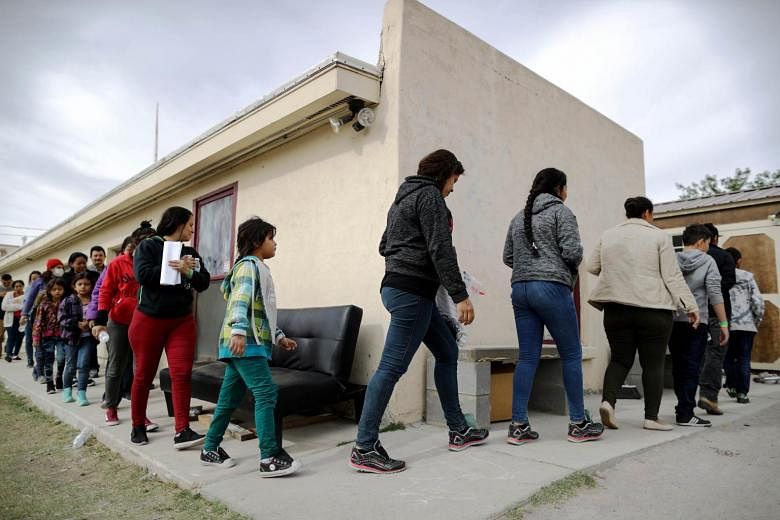SAN DIEGO (NYTIMES) - At its peak, the non-profit shelter run by Jewish Family Service of San Diego held more than 300 migrants dropped off by United States immigration authorities after they crossed the border from Mexico. Some days this spring were so busy that new arrivals had to be sent to overflow sites.
Now, the shelter is almost eerily empty. The number of people arriving there has plunged in recent weeks amid a precipitous decline in arrivals along the southern border, where the Department of Homeland Security said that apprehensions dropped 28 per cent in June.
While migrant arrivals typically decline as the hot, hazardous summer months set in, the Department of Homeland Security said the drop in June was much larger than the 11 per cent drop in the same month last year.
The difference suggested that the Trump administration's long push to curtail the arrival of migrants at the south-west border is finally showing results.
President Donald Trump has made it a cornerstone of his administration to halt the flow of undocumented migrants, expanding security fencing, slowing processing at ports of entry and locking up record numbers of migrants.
The threat of tariffs helped push Mexico to deploy security forces on its own southern border, curtailing the flow of migrants from neighbouring Guatemala.
A second initiative has forced many migrants to return to Mexico to await the outcome of their asylum or deportation cases in US immigration courts. More than 18,000 migrants, including asylum seekers, have been returned to Tijuana and other Mexican cities since the policy was put into place, according to Mexico's National Migration Institute.
"These initiatives are making an impact," the Department of Homeland Security said in a statement.
At the non-profit shelter in San Diego, the effects have been drastic. Last Friday (July 5), not a single migrant arrived - a first for the facility since it opened last October.
"We have been startled by the stark decline that happened virtually overnight," said Ms Kate Clark, senior director of immigration services at the shelter. "US immigration authorities are not bringing families who have been processed to the shelter because they are returning them to Mexico."
Tijuana, by contrast, is still full of migrants - many of them turned back at the border under the Trump administration's "Remain in Mexico" programme.
"The United States' policy to return people to Mexico and the pressure on Mexico to stop the migration are having a big impact," said Mr Daniel Bribiescas, an immigration lawyer in Tijuana.
The Instituto Madre Asunta, a shelter for migrant families just south of the border, has for several weeks packed in more than three times the number of people it is designed to accommodate. Mothers and children from Central America and Haiti have been sleeping in a classroom converted into a dormitory, many atop mattresses on the floor.
"We're doing our best to sleep 140 people, but we only have 44 beds," said Ms Adelia Contini, the nun who runs the facility, which is in a residential neighbourhood, with a shelter for fathers and children that was also over capacity. Some families have been at the Madre Asunta shelter for months, after US immigration authorities sent them to Mexico with instructions to show up at the San Ysidro, California, port of entry at dawn on the day of their immigration hearing to be transported to court.
Mexico's own heightened border security is also having an effect. To make good on a deal struck with Mr Trump last month to avert trade tariffs, more than 20,000 Mexican security forces, including members of the newly formed National Guard, have been deployed throughout the country's southern and northern border states. Mexican authorities have been trying to plug well-known but illegal crossing points along their southern border, and have set up checkpoints along major highways to intercept vehicles carrying undocumented migrants.
In Tijuana, officers have been stopping and arresting migrants who do not have papers. The Department of Homeland Security said there had been a "substantial increase" in the number of interdictions on Mexico's southern border. In a conference call with reporters on Wednesday (July 10), a Customs and Border Protection official said Mexico's deployment of forces on its northern frontier had helped stop "large groups" of migrants before they could cross into the United States.
The official, who spoke on condition of anonymity, said agents had apprehended 15 groups of 100 or more migrants in June, down from 48 such groups in May. "I would attribute to Mexico for making some difference," the official said.
The decline in arrivals in June has helped reduce overcrowding at border facilities. About 200 children are currently being held in Border Patrol centres, compared with roughly 2,500 in May, the official said.
He said a US$4.6 billion (S$6.26 billion) border aid package approved last month by Congress, which gave about US$3 billion to the Department of Health and Human Services, had allowed that agency to more quickly move children out of Border Patrol facilities and into its own, better-equipped shelters.
With more Central Americans stuck in Mexico and hoping to go home, the International Organisation for Migration began last week to provide free bus service from Ciudad Juarez, Mexico, to Guatemala and Honduras. Buses left last week carrying 67 migrants back home. A second group of 70 boarded buses on Tuesday.
The agency plans to begin offering a similar bus service from Tijuana in the coming days.

